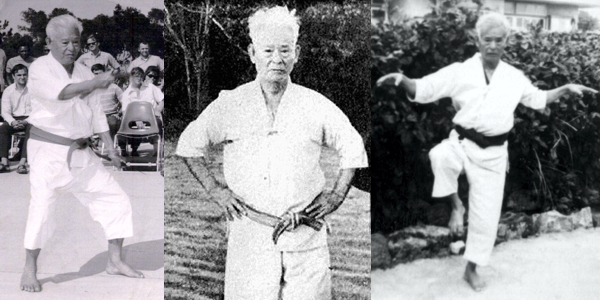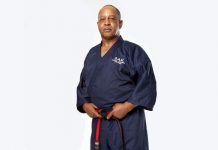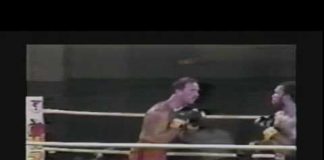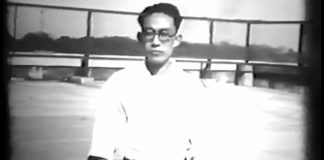 Okinawan martial arts master, Hohan Soken founded the Shorin-ryu Matsumura Seito Okinawa Karate Kobudo Association
Okinawan martial arts master, Hohan Soken founded the Shorin-ryu Matsumura Seito Okinawa Karate Kobudo Association
Hohan Soken was born on May 25, 1889 and lived in Gaja Village, Nishihara City, Okinawa prefecture during the 24th year of Meiji. This was better known as the Meiji Restoration, a period when great social and political changes occurred in Okinawa and Japan. The centuries old feudal system evolved into modern social and political systems due to contact and trade agreements with Europe. The samurai class of nobility suddenly found themselves having to take on menial farming and merchant tasks alongside the common peasants they once protected and ruled. In addition, the old samurai’s were forced to abandon many of the old traditions, such as cutting off their topknot’s, the growth of hair on top of their heads that distinguished them as honored nobility, and the ability to carry their swords in public. Since the advent of guns from Europe meant that average citizens could be drafted and quickly trained to fulfill the military needs in European styled armies, the “bushi” (samurai) classes of warriors were no longer needed. There are stories of samurai’s, such as Matsumura Nabe, taking up lowly jobs such as rickshaw drivers just in order to survive. Still they performed these tasks with the dignity and tenacity befitting their samurai heritage.
Matsumura Nabe was the grandson of the famous samurai Kayo Sokon (Bushi) Matsumura, the chief bodyguard of the king of Okinawa, and head trainer of the Okinawan military. Matsumura Sokon, since his son had died in battle, had chosen Nabe to carry on the family art of Uchinan Sui-de, better known as Shuri-Te. Thus Nabe was the second-generation inheritor of the family martial arts system. As Matsumura Sokon’s student, he probably also trained with karate greats such as Itosu Ankoh and Azato Ankoh.
Nabe began looking for another family member to carry on the Matsumura Uchinan Sui-di family tradition when, like his grandfather Sokon Matsumura, Nabe’s son had also died before the family Sui-di tradition could be passed on. So his eye fell upon his sister’s young son Soken Hohan, the only one of the family who expressed interest in learning and training in the old samurai ways.
Nabe kept a watchful eye on his nephew and when Soken was around 14 years old (around 1902 or 1903) Nabe, seeing his potential, told him that if he could demonstrate the patience and discipline befitting of his Samurai heritage, he would train him in the family art of te. Young Soken quickly accepted and Nabe began training him in the fundamentals. About ten years later Nabe thought Soken was ready, and began teaching him the secretive Matsumura family system, which was based on the Chinese martial art called White Crane (Hakutsuru).This made Hohan Soken the third generation inheritor of Matsumura Uchinan Sui-di.
These were hard times for the Matsumura family, who now made a living by farming alongside the peasants they once ruled. So training for the young Soken started early in the morning before going out to the fields, and then continued late into the night, after the day’s work had been done. Training was tough, and often brutal in the tradition of the old samurai’s. This training included balance training on slick banana leaves and on different levels and types of ground. Later kata’s and sparring was done on more dangerous floating logs and small rafts.
Hohan Soken also trained in Kobujutsu under an old samurai named Komesu Ushi no Tanmei, of the city of Nishihara. Komesu Ushi was also well versed in Shuri Ryu due to his training under Sokon Matsumura. Young Soken’s kobudo training, especially with a bo, was taught to him by Tsueken Mataka, the developer of the now famous Tsueken no Bo kata.
Around 1922 Hohan Soken, along with Mabuni Kenwa (founder of Shito Ryu), Taira Shinken (the famous kobudo master), Chibana Chosin (founder of Kobayashi Shorin Ryu), Moden Yabiku founder of Ryuku Kobujutsu Kenkyu-Kai), a Chinese tea merchant named Wu Hsein Kuei, better known as Gokenki, the White Crane Kung Fu master, and a karate master called Kanamude formed the Genku Ki dojo to train and trade techniques. It should be noted that several of these noted masters had trained directly under Itosu Ankoh. It is said that a disagreement with Master Kanamude was one of the reasons that Hohan Soken had decided to go to Argentina. Around this time Soken Hohan had developed a close friendship with a famous Okinawan karate master, Kyan Chotoku.
Between 1919 and 1924 Soken Hohan left Okinawa to go to Negro, Argentina to find his fortune. Some say that his friend, Kyan Chotoku, had planned on going with him, but at the last minute had decided to stay in Okinawa. Soken Hohan stayed in Argentina all through WWII, marrying, having children and working in a clothes cleaning business, as well as becoming a photographer. He also learned and became fluent in the Spanish language. It is reported that he did teach karate during this time, even performing several karate demonstrations. It is said that he only trained 4 students, named Kana, Mitake, Higa and Misugi, (first names unknown) all now deceased.
Hohan Soken told two stories about his departure from Okinawa, and his life in Argentina. The first occurred as he was stepping onto the gangplank going onto the boat. A large wave came across the gangplank, almost washing him overboard. Since Okinawan waters are usually full of very sharp coral, combined with the fact that Soken could not swim, this quickly became a life-threatening event, however the Hakutsuru (White Crane) balance training, including all of the times he practiced kata and sparring while standing on a floating log or raft, allowed him to catch his balance, thereby saving his life.
The other story happened while he was living in Argentina. Apparently during a demonstration one of his students brought him a piece of wood to break. Noticing the grain of the wood, Soken sensei positioned the wood to break it with a shuto (karate chop).Instead of the wood breaking, Soken Sensei’s hand split open from his little finger to his wrist. After a closer inspection he discovered that the piece of wood he was attempting to break was ironwood, one of the densest of all woods. From that point on, he always inspected any wood he was going to break to make sure it wasn’t ironwood. These two stories came from an audio interview owned by Charles Garrett. In the interview, he also mentions he used to work out and practice along with Gichin Funakoshi, the founder of Shotokan, and who is often called “the father of Japanese Karate”. This would mean that Hohan Soken probably had contact with, or was influenced by both Itosu Ankoh, and Azato Ankoh – both students of Matsumura Sokon.
He returned to Okinawa thirty years later, in 1952, to discover that karate had greatly changed, and that his friend Kyan Chotoku had died of starvation right after the end of WWII. Karate in Okinawa had changed to such an extent that even the kanji of the name Kara-Te changed from meaning “Chinese Hand” to “Empty Hand”. In addition, the old hard training way he had been taught as a youth had been replaced with a softer, more sports oriented style of karate. He refused to change his training methods, and so he quickly became known as one of the last of the old masters. In fact, in his later years he became known, and was even featured in “Ripley’s Believe it or Not” as the “last Samurai” because he was the last survivor of the generation that was born into the Samurai (Bushi) class of warriors who had been trained in the old samurai methods of karate.
Originally, when he came back from Argentina, he called his system “Machimura (Uchinan) Sui-di” (Matsumura Shuri-Te), but in 1956 he officially changed the name to “Shorin Ryu Matsumura Seito (Orthodox) Karate-Do”. Although there are many very good styles that have roots going to Matsumura Sokon, Shorin Ryu Matsumura Seito Karate-Do as taught by Soken Hohan is the one that has remained closest to the teachings of Matsumura Sokon. Soken Hohan himself said: (taken in part from an interview by Ernest Estrada) “I should also state that Matsumura Orthodox is not the only authentic Shorin Ryu style. This style, my style, was passed on from Matsumura Sokon to my uncle, Nabe-tanmei but Nabe-tanmei was not Bushi Matsumura’s only student. Matsumura had a good dozen or so dedicated students. Each one learned his methods and then expanded on them. My uncle only learned from Bushi Matsumura and only taught me what he had learned. So, it can be said that it is an “old version” with no updates. By studying my Matsumura Orthodox you walk back into ancient times when karate was more forceful and challenging.”
In 1961 the Okinawa Kobudo Kyokai recognized Hohan Soken for his contributions to the Okinawan kobudo arts by formally awarding him a master’s rank. In 1967 the Okinawa Karate Kobudo Renmei also formally recognized and presented to Hohan Soken another mastersgrade in both karate and kobudo. He became a much sought after “Master of Teachers” in Okinawa, with students that read as a “who’s who” in the world of karate today, including the likes of Arakaki Seiki, Nishihira Kosei, Kuda Yuichi, Kise Fusei , Toma Seiki, Nakazato Hideo, Higa Mitake, and of course Inoue Mitsuo and Akamine Yoshimatsu. It was also in the very early 1960’s that he began to teach Americans, mostly American servicemen introduced to him by one of his top students, Fusei Kise.
It was also during this time that he became president of the “All Okinawa Kobujutsu Association”, and was heavily involved in the various activities of the “Ryukyu Historical Society” whose goal was to preserve the roots and customs of the Okinawan people. In addition, he became involved with many of the karate organizations in Okinawa such as the “All Japan Karate-Do League” and the “All Okinawa Karate Kobudo”, as well as the “Seishinkan” which later became the “All Okinawan Shorin Ryu Kenshinkan Karate & Kobudo Federation” and his own “Shorin Ryu Matsumura Orthodox Karate-do Association (SMOKA)” and “Okinawan Karate Federation (OKF)”.
Soken Hohan formally retired from teaching in 1979 leaving several of his top students to carry on his teachings and traditions, He still on occasion acted as consultant to several of his top students. Around 1980 he allowed Inoue Mitsuo to form the “Okinawa Shorin Ryu Matsumura Seito Karate Do Hozon Kai”.
Soken Hohan died on November 30, 1982 at the age of 93. According to his obituary, Arakaki Seiki was listed as Matsumura Seito’s representative at his funeral. But his style and traditions probably were never passed down to any one person. Instead, he passed different parts of his style to all of his students. It has been surmised by many who knew him that he may have done this so that all of his students would have to come together in harmony in order to get his entire system.
Soken, as with Nabe, had 2 wives. One was from Argentina, the other from Okinawa. None of his sons took an interest in their father’s tradition. One of Soken’s Sensei’s sons by his first wife followed Soken Sensei back to Okinawa and had kept Soken Sensei’s ashes. When that son recently passed away, Soken Sensei’s ashes returned to Argentina were, in accordance with Okinawan custom, they were left in the care of the son’s Argentinean wife and children. Having O’sensei’s ashes in Argentina, and his grave and memorial in Okinawa is fitting for a man with such deep ties in both places.
If one wishes to pay respect to Soken O’sensei, we at the Hozon Kai join with the Shorin Ryu Matsumura Seito Suiken Bugei Kai in asking that one do so at the grave and memorial in Okinawa to avoid causing the deep offense inherent in trying to make a Grace-land style pilgrimage to Argentina.
Our thanks to all who assisted in, or who provided information for the writing of this biography, in particular the direct students of O’sensei Soken who through the years have generously provided information through their gracious sharing of their martial arts experience.
- Bibliography (in part):
• “Interview with Hohan Soken”; Article by Ernest Estrada
• “The White Swan of Hohan Soken; Article by Don Lucas; Black Belt Magazine
• “The Bible of Karate – Bubishi”; by Patrick McCarthy
• “Okinawa Island of Karate”; Video by George Alexander
• “Hohan Soken – The Life of a Grandmaster”; Video by George Alexander
• “Audio interview of Hohan Soken”; Owned by Charles D. Garrett II
• Articles found on the Shorinryu Matsumura Seito Suiken Bugei Kai website (by permission)
• “Personal discussions with direct students of Hohan Soken”; Ron van de Sandt
• And a variety of articles, websites and books collected throughout the years.






